Interchangeable lens 35mm rangefinder cameras made their debut over 90 years ago when Leitz introduced the Leica II and Zeiss debuted the Contax I. The first lenses for these cameras were Tessar formula lenses of modest speed. The 5cm F3.5 Tessar was produced in Contax RF mount in 1931, and was soon followed by the 5cm F2.8 Tessar a few months later. The 5cm F2.8 Tessar was a poor performer used wide-open, too far of a stretch of the 4 element in 3 groups, 1-1-2 design for the available glass of the day. The Leica II was introduced with the Elmar 50mm F3.5, also a Tessar type 1-1-2 design. The Elmar has the aperture behind the front element rather than the middle element as it is on the Zeiss Tessar. Leitz soon introduced the 50mm F2.5 Hektor, a 6 element in 3 groups, 2-2-2 formula lens. This lens is also soft used wide-open. The race for speed was on.
Ludwig Bertele’s Sonnar is a break-through formula that embodies fast optics in a compact design. 2021 is the 90th birthday of Bertele’s 5cm F2 Sonnar. This lens is the first Sonnar to be introduced for the new Contax camera. 2022 is the 90th birthday for the 5cm F1.5 Sonnar.
2022 was a good year for me, two very special Sonnars came my way. The first- Ninety years after it was manufactured, a Carl Zeiss Jena 5cm F1.5 Sonnar from the first batch of 100 lenses completed, October 1932. This can be considered the trial batch, the optical formula and design of the lens was changed soon after. The second very special Sonnar is the Skyllaney pre-production 5cm F2 Bertele Sonnar.
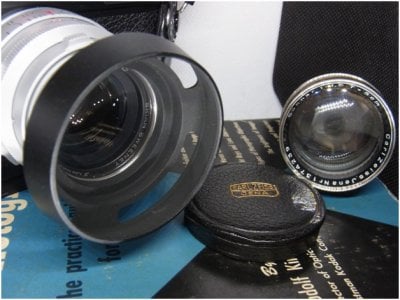
Zeiss and Leitz brought out full lines of interchangeable lenses for their cameras, and dominated the market for 35mm format. The design philosophies of the two companies were very different.
Leitz designers believed that lenses should be highly corrected with small amounts of residual aberration. Their designs made use of double-Gauss optics, lenses with highly symmetric designs. Pairs of similar image-forming optics, placed back-to-back, will cancel out aberrations. Think of two prisms placed back-to-back: the first splits white light into a rainbow, the second prism combines the rainbow back to white light. The optical pairs are “highly symmetric”, not “completely symmetric”. In the 1920s it was found that introducing a small amount of asymmetry into the symmetric Planar formula lens allowed for much wider apertures. The Summar 5cm F2, Xenon 5cm F1.5, and Summitar 5cm F2 of the 1930s were well-corrected for distortion, highly color-corrected, and had a reputation for fine resolution. The Xenon is a 7 element in 5 group optic, with 10 air/glass interfaces. These lenses were not coated, and each air/glass interface reflected 4% of the light coming through it. The result is lower contrast and almost 1 F-Stop loss in transmission. All of these lenses used soft glass for the front element, making it very difficult to find one in good condition. If you do, the Bloom on the glass acts as a natural lens coating. Bloom is oxidation of the glass, which changes the refractive index of the surface. This reduces reflections. Good copies today perform better than when they were new.
Ludwig Bertele placed more importance on producing a bright image with high contrast. His designs minimized the number of air/glass interfaces using groups of cemented elements in asymmetric designs. Ludwig Bertele worked for Ernemann (Krupp-ErnemannKinoapparate AG) and developed the “Ernostar” F2. This lens had 5 elements in 4 groups, an asymmetric 1-1-1-2 configuration, eight air/glass interfaces. Ernemann merged with Zeiss, and Bertele created their most famous lens of the 1930s by filling in the space between the 2nd and 3rd element of the Ernostar with low index of refraction glass. This improved transmission by almost 10%. Corrections for flatness of field and geometric distortion were secondary to transmission of light.
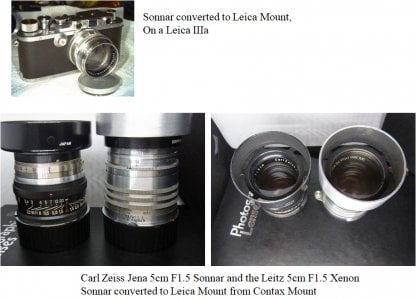
Ludwig Bertele’s Sonnar is a break-through formula that embodies fast optics in a compact design. 2021 is the 90th birthday of Bertele’s 5cm F2 Sonnar. This lens is the first Sonnar to be introduced for the new Contax camera. 2022 is the 90th birthday for the 5cm F1.5 Sonnar.
2022 was a good year for me, two very special Sonnars came my way. The first- Ninety years after it was manufactured, a Carl Zeiss Jena 5cm F1.5 Sonnar from the first batch of 100 lenses completed, October 1932. This can be considered the trial batch, the optical formula and design of the lens was changed soon after. The second very special Sonnar is the Skyllaney pre-production 5cm F2 Bertele Sonnar.

Zeiss and Leitz brought out full lines of interchangeable lenses for their cameras, and dominated the market for 35mm format. The design philosophies of the two companies were very different.
Leitz designers believed that lenses should be highly corrected with small amounts of residual aberration. Their designs made use of double-Gauss optics, lenses with highly symmetric designs. Pairs of similar image-forming optics, placed back-to-back, will cancel out aberrations. Think of two prisms placed back-to-back: the first splits white light into a rainbow, the second prism combines the rainbow back to white light. The optical pairs are “highly symmetric”, not “completely symmetric”. In the 1920s it was found that introducing a small amount of asymmetry into the symmetric Planar formula lens allowed for much wider apertures. The Summar 5cm F2, Xenon 5cm F1.5, and Summitar 5cm F2 of the 1930s were well-corrected for distortion, highly color-corrected, and had a reputation for fine resolution. The Xenon is a 7 element in 5 group optic, with 10 air/glass interfaces. These lenses were not coated, and each air/glass interface reflected 4% of the light coming through it. The result is lower contrast and almost 1 F-Stop loss in transmission. All of these lenses used soft glass for the front element, making it very difficult to find one in good condition. If you do, the Bloom on the glass acts as a natural lens coating. Bloom is oxidation of the glass, which changes the refractive index of the surface. This reduces reflections. Good copies today perform better than when they were new.
Ludwig Bertele placed more importance on producing a bright image with high contrast. His designs minimized the number of air/glass interfaces using groups of cemented elements in asymmetric designs. Ludwig Bertele worked for Ernemann (Krupp-ErnemannKinoapparate AG) and developed the “Ernostar” F2. This lens had 5 elements in 4 groups, an asymmetric 1-1-1-2 configuration, eight air/glass interfaces. Ernemann merged with Zeiss, and Bertele created their most famous lens of the 1930s by filling in the space between the 2nd and 3rd element of the Ernostar with low index of refraction glass. This improved transmission by almost 10%. Corrections for flatness of field and geometric distortion were secondary to transmission of light.

Last edited:
The Carl Zeiss Jena 5cm F2 Sonnar and Leitz Summar 5cm F2 first Fast lenses offered for the Contax and Leica respectively.
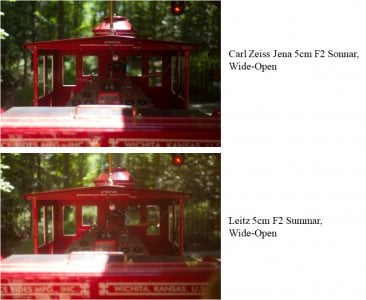
The Sonnar design has two less air/glass surfaces, more transmission and higher contrast. The Summar has better flatness of field, and more astigmatism. "Swirly Bokeh" is the result.
In 1932, Zeiss brought out the 5cm F1.5 Sonnar with 6 air/glass interfaces. Leica brought out the 5cm F1.5 Xenon, 7 elements in 5 groups for 10 air/glass interfaces. For low-light work, the Sonnar is the clear choice.
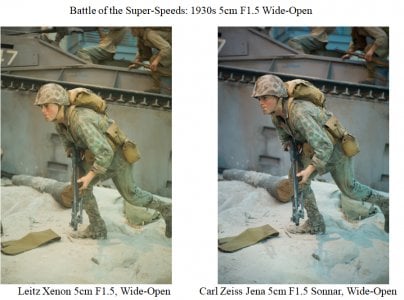
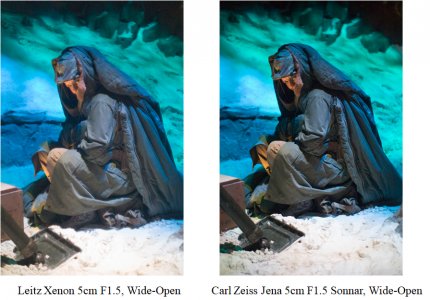
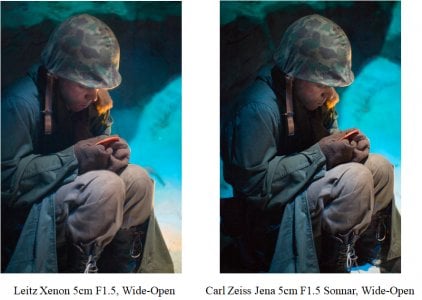

The Sonnar design has two less air/glass surfaces, more transmission and higher contrast. The Summar has better flatness of field, and more astigmatism. "Swirly Bokeh" is the result.
In 1932, Zeiss brought out the 5cm F1.5 Sonnar with 6 air/glass interfaces. Leica brought out the 5cm F1.5 Xenon, 7 elements in 5 groups for 10 air/glass interfaces. For low-light work, the Sonnar is the clear choice.



Last edited:
The classic Sonnar was the super-speed lens of choice of the 30s and 40s. The 5cm F2 Sonnar was 6 elements in 3 groups, 1-3-2 configuration. The 5cm F1.5 Sonnar was 7 elements in 3 groups, 1-3-3 configuration. Add them up- 6 air/glass interfaces for more transmission of light compared to the 10 surfaces of the Leitz 5cm F1.5 Xenon. The front element of the 5cm F2 Sonnar is soft, similar to the Leitz lenses. The front element of the 5cm F1.5 Sonnar is hard, making it much easier to find a clean example. Scratches and cleaning marks are common on the F2 Sonnar, as they are on the Leitz Summar, Xenon, and Summitar. This is one of the reasons why Skyllaney chose to build the 5cm F2 lens. Some 20 years ago I was lucky to have found a 1934 5cm F2 Sonnar that had a filter on it from the time it was sold. That lens is also the first that I converted to Leica Thread Mount using a Jupiter-8 focus mount. It is the lens that I dropped in the case to shoot alongside the new Bertele. The Bertele optical design is based on the 1934 5cm F2 Sonnar, and mine is as perfect as can be found. The optical fixtures and focusing mount of the Bertele have the build and precision of an Optical Laboratory instrument. The level of engineering and construction of this lens sets it apart from every Leica Mount Sonnar that I’ve used. The Bertele Sonnar is an engineering masterpiece, every detail of mechanical design thoroughly thought out.
The Sonnar is an “Asymmetric” configuration: the front section is a telephoto design with a focal length about 2.5x the overall focal length of the lens; the rear group is about the same as the final focal length. This gives the Sonnar a compact design. The Sonnar is often labeled as a derivative of Taylor’s Cooke Triplet and Zeiss Tessar. These designs share similar traits: the front group is a positive focal length, the middle group is a negative focal length, and the third group is a positive focal length. The difference between the designs is in the relative power of each group, which distinguishes the rendering of the Sonnar from the Tessar. With Taylor’s triplet and the Zeiss Tessar, the front element and rear element are both image forming optics, and the middle element can be combined with the rear element to form an image with a large back-focus. The middle element is a strong negative focal length, and the combination of front element and middle element has a negative focal length and does not form an image. This gives the Triplet and Tessar a greater back-focus. The Sonnar differs in relative powers: the front and rear group are also each image forming optics. The combined middle group and rear group also forms an image. The difference with the Sonnar: the front element and middle group forms a telephoto lens. The groups are brought together with close spacing to form the final image, giving the Sonnar a compact design with a short back-focus. Technically, the Sonnar formula “suffers” from spherical aberration, coma, and field curvature. In practice, these imperfections produce a pleasing signature, a unique blend of “perfect imperfections”.
The Sonnar design introduces more spherical aberration than is present in a symmetric type lens. The focal length of the center of the 5cm Sonnars is longer than the focal length of the edges. This means the best focus point of light entering the Sonnar from the center is behind that of light entering from the edge.
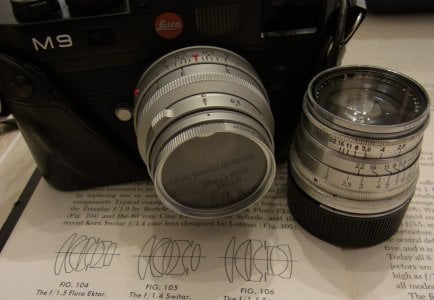
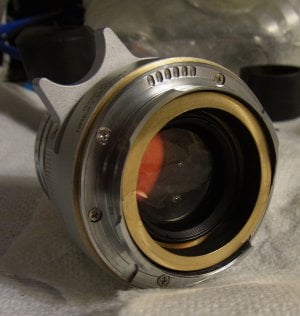
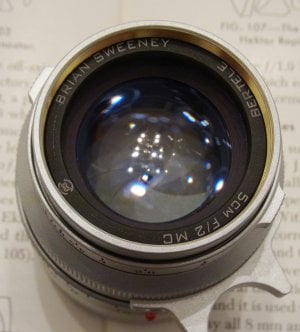
The Sonnar is an “Asymmetric” configuration: the front section is a telephoto design with a focal length about 2.5x the overall focal length of the lens; the rear group is about the same as the final focal length. This gives the Sonnar a compact design. The Sonnar is often labeled as a derivative of Taylor’s Cooke Triplet and Zeiss Tessar. These designs share similar traits: the front group is a positive focal length, the middle group is a negative focal length, and the third group is a positive focal length. The difference between the designs is in the relative power of each group, which distinguishes the rendering of the Sonnar from the Tessar. With Taylor’s triplet and the Zeiss Tessar, the front element and rear element are both image forming optics, and the middle element can be combined with the rear element to form an image with a large back-focus. The middle element is a strong negative focal length, and the combination of front element and middle element has a negative focal length and does not form an image. This gives the Triplet and Tessar a greater back-focus. The Sonnar differs in relative powers: the front and rear group are also each image forming optics. The combined middle group and rear group also forms an image. The difference with the Sonnar: the front element and middle group forms a telephoto lens. The groups are brought together with close spacing to form the final image, giving the Sonnar a compact design with a short back-focus. Technically, the Sonnar formula “suffers” from spherical aberration, coma, and field curvature. In practice, these imperfections produce a pleasing signature, a unique blend of “perfect imperfections”.
The Sonnar design introduces more spherical aberration than is present in a symmetric type lens. The focal length of the center of the 5cm Sonnars is longer than the focal length of the edges. This means the best focus point of light entering the Sonnar from the center is behind that of light entering from the edge.



Last edited:
Used wide open, the image is dominated by light coming in at the shorter focal length of the edges. This is responsible for the lower-contrast/spread-out depth of field of the Sonnar when used wide open. Stopping down the aperture eliminates contributions from the edge; the image that remains is the product of the longer focal length center of the lens. It “shifts” towards infinity. A decision must be made for the optimization of the lens, the critical F-Stop in which the focus of the lens agrees exactly with the rangefinder of the camera. Ludwig Bertele chose to optimize his 5cm F1.5 Sonnars for use at F2, about 1 stop down. The prior owner of my 1932 5cm F1.5 Sonnar had the lens rotated in the barrel for best use at F1.5, the movement required is consistent with “about” 1 stop. It is now at the as-built position. The early 5cm F2 Sonnars that I have are optimized for about 2/3rds stop down. When converting Sonnars to Leica mount, I set them for wide-open use. I’m used to correcting the focus when stopping down. Skyllaney followed Bertele’s lead, and optimized the Bertele Sonnar for slightly stopped-down use, “about” F2.4. That messed up my mental algorithm for focus shift compensation, and I ended up using the variable stand-off ring to optimize for wide-open use. That is why the Aperture index on my lens no longer lines up with the focus index on my lens, but is pointed at the Viewfinder. Right where I like it, an added bonus! When focusing with the rangefinder, I can see the aperture index in the far corner of the viewfinder outside of the framelines. I tend to drop the camera to waste level when using the focus scale. There is a pony in here.
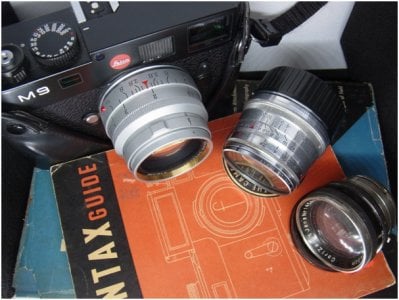
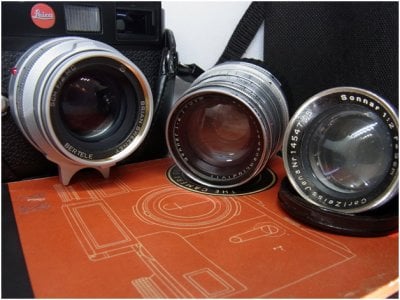


Last edited:
I’ve been using the Bertele Sonnar alongside of my 1934 5cm F2 Sonnar since December 2022, on the Leica M9 and M Monochrom. I often take lenses to the Marine Corp Museum in Quantico, VA. The lighting is consistent and the subjects stay still. This gives a good way of doing a “walking around test” of various cameras and lenses and being able to compare results. The Bertele is sharper, and has higher contrast than the original- as seen in the side-by-side comparisons. Using the two lenses, the precision of the Bertele focus mount and aperture is among the best I’ve ever used. Including custom lenses made-to-spec for scientific work where we had the barrels made in inconel. That is expensive. The Bertele is all-brass, also expensive- but not as much as inconel. The build-quality of the First-Type Rigid Summicron 5cm F2 comes to mind when handling the Bertele. This lens recreates the rendering of the Sonnar 5cm F2 with modern multi-coated optics in a precision made barrel and focus mount that would make Ludwig Bertele proud. I am very proud to own and use this lens. I had a great Christmas!
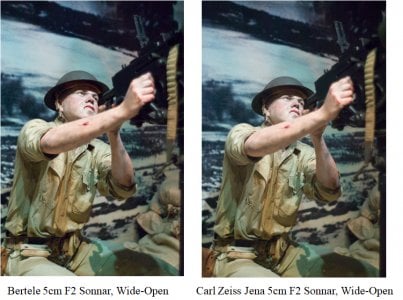
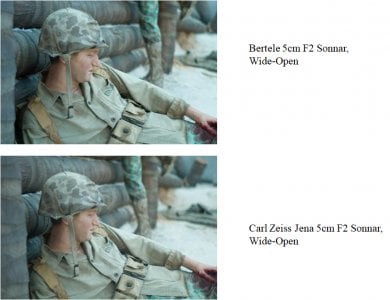
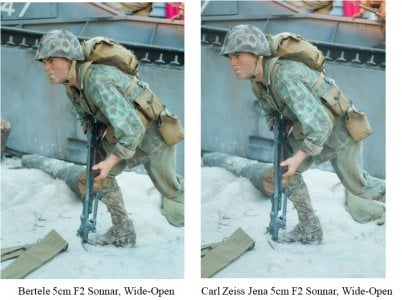
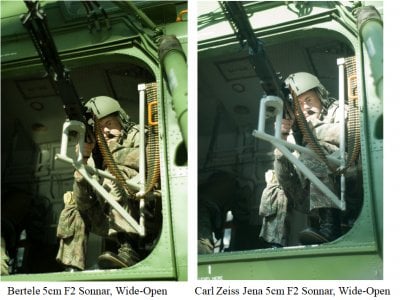
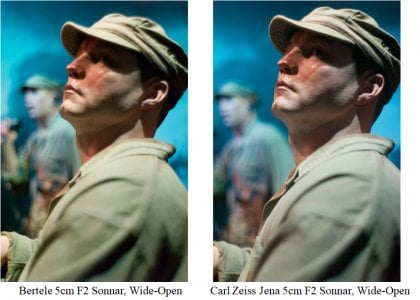
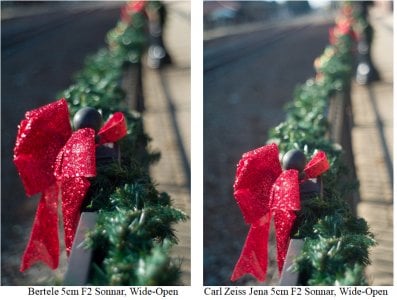






MarkWalberg
Established
Brian, thank you, not only for the history, but for the perspective and the example pictures (the hard data).
The helicopter gunner pictures seem to be the most different, with the Skyllanie lens showing more both in the highlights and the shadows. The other comparisons are very interesting as well. Again, thanks for doing this.
The helicopter gunner pictures seem to be the most different, with the Skyllanie lens showing more both in the highlights and the shadows. The other comparisons are very interesting as well. Again, thanks for doing this.
Last edited:
Skyllaney posted this update today
That non-linear focusing cam!
Cool reference to @Sonnar Brian and a circular link back to this thread.
That non-linear focusing cam!
Cool reference to @Sonnar Brian and a circular link back to this thread.
BWF
Established
Very exciting that the Bertele is coming to market. The rendering looks great. Has there been any indication of the price point?
raid
Dad Photographer
I am so tempted!
Thanks, Brian.
Thanks, Brian.
Coldkennels
Barnack-toting Brit.
Reading about the machining of the components was interesting... but who's creating the optical elements?
wlewisiii
Just another hotel clerk
Have they established pricing on the new lenses yet?

‘Bertele’ 2023 update
It’s been three years since we announced our ’50mm f/2 Bertele’ project. We hoped to start accepting pre-orders as early as 2021, but life (and business) doesn’t always foll…
 skyllaney.com
skyllaney.com
I was honored to be able to provide input into the design of this lens. I was notified a few days ago that the announcement was coming and that I could share my experience with the lens. I'll be posting more pictures from it, from the M9 and M Monochrom. I'll also upload some higher-res images. Noted is the statement in the article that production lenses will be optimized for wide-open use! Mine was originally optimized for slightly stopped down, which I changed on the second day. So- this fits into the DIY nature of this forum...
I have "at least one" 50mm F2 Sonnar formula lens from Zeiss Jena pre-war, wartime, post-war; Zeiss Opton; Nikon collapsible and late Rigid, Tanack, KMZ, Arsenal, and now the Bertele. My 1934 5cm F2 Sonnar used for the comparison above is the best that I've seen. It performs better than the Two 5cm f2 T Sonnars that I converted to Leica mount and currently own. As seen above in the Photo of the Helicopter Gunner- the original Sonnar loses contrast from the strong sunlight hitting the metal in the image, producing flare. The multicoated optics of the Bertele Sonnar handled the harsh lighting conditions perfectly.
boojum
Mentor
My pinhead impression of the Skyllaney vs the other Berteles is that the new Skyllaney Bertele has better 3D modeling in addition to its other attributes. The compared images seem flatter to me. Emphasis on the "to me." Can they bring it to market for ~$500? ROTFLMAO It is going to tempt many and it would not surprise me to see an additional production run. I am sure they are counting on it. I need another Leica mount 50 like a hog needs roller skates, but, . . .
wlewisiii
Just another hotel clerk
There is no such thing as too many 50's  Endless diversity
Endless diversity 
Though I do wonder how the sonnar I currently own, a Nikkor-H 50/2 would compare...
Though I do wonder how the sonnar I currently own, a Nikkor-H 50/2 would compare...
boojum
Mentor
Brian has advised me that the '51 J8 I have, which he had in order to tweak and tune, is actually a 5cm Sonnar. I guess it is so early in the Soviet run that they were not only using German machines and engineers but were still using the German stock to build lenses. Color me lucky at US$99 for that one.
I want to test it against the '57 J8 and the Amotal on the M9. As the Bertele Sonnar/Jupiter has a field of view of 45mm it covers the X2D sensor. I checked and Skyllaney is right. So I will also test the J8's on the X2D. The Amotal does not have a large enough field of view and has corner astigmatism.
To be quite honest, I have enough 50's for me. I have a couple of Canons, too, the f/1.8 is quite nice. I need skills more than I need lenses.
I want to test it against the '57 J8 and the Amotal on the M9. As the Bertele Sonnar/Jupiter has a field of view of 45mm it covers the X2D sensor. I checked and Skyllaney is right. So I will also test the J8's on the X2D. The Amotal does not have a large enough field of view and has corner astigmatism.
To be quite honest, I have enough 50's for me. I have a couple of Canons, too, the f/1.8 is quite nice. I need skills more than I need lenses.
Last edited:
dexdog
Mentor
Umm, I am thinking your guess is off by a factor of 8 or 9!My pinhead impression of the Skyllaney vs the other Berteles is that the new Skyllaney Bertele has better 3D modeling in addition to its other attributes. The compared images seem flatter to me. Emphasis on the "to me." Can they bring it to market for ~$500? ROTFLMAO It is going to tempt many and it would not surprise me to see an additional production run. I am sure they are counting on it. I need another Leica mount 50 like a hog needs roller skates, but, . . .
I've seen people sell the Sonnar conversions that they bought from me for several hundred dollars more than the original price. I know how much time and effort goes into doing a CLA on the Sonnar and Jupiter mounts directly. Those people do not get to buy a second one from me. I've also had custom lenses made to spec for work. I know how much this type of work cost.
Some projects are done to make a profit, some out of necessity, and a few are to show what the engineers of a company can pull off through sheer dedication to the craft. The Bertele Sonnar is one of the latter.
Some projects are done to make a profit, some out of necessity, and a few are to show what the engineers of a company can pull off through sheer dedication to the craft. The Bertele Sonnar is one of the latter.
Last edited:
boojum
Mentor
Oh, please do not interrupt my dreams.Umm, I am thinking your guess is off by a factor of 8 or 9!
boojum
Mentor
Some people are jerks.I've seen people sell the Sonnar conversions that they bought from me for several hundred dollars more than the original price. I know how much time and effort goes into doing a CLA on the Sonnar and Jupiter mounts directly. Those people do not get to buy second one from me. I've also had custom lenses made to spec for work. I know how much this type of work cost.
Some projects are done to make a profit, some out of necessity, and a few are to show what the engineers of a company can pull off through sheer dedication to the craft. The Bertele Sonnar is one of the latter.
That Skyllaney Bertele Sonnar is pretty seductive. Their blurb indicates it to be real quality, start to finish, and of a great lens formula tweaked just a bit to get it as about as good as mere mortals can.
The Clarity in the photos from the Bertele Sonnar are amazing. It is better than any of my F2 Sonnars. On my list to compare with- the C-Sonnar and "perfect-glass" original CZJ LTM 5cm F1.5 Sonnar T. The mount of the Bertele is better designed than the C-Sonnar, which can pick up a "Wobble". There is no backlash as often appears in the classic LTM Sonnars.
Share:
-
This site uses cookies to help personalise content, tailor your experience and to keep you logged in if you register.
By continuing to use this site, you are consenting to our use of cookies.

